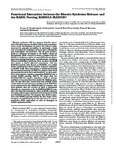Functional interaction between the Bloom's syndrome helicase and the RAD51 paralog, RAD51L3 (RAD51D).
| dc.contributor.author | Braybrooke, JP | en |
| dc.contributor.author | Li, J-L | en |
| dc.contributor.author | Wu, L | en |
| dc.contributor.author | Caple, F | en |
| dc.contributor.author | Benson, FE | en |
| dc.contributor.author | Hickson, ID | en |
| dc.date.accessioned | 2017-11-27T15:47:37Z | |
| dc.date.available | 2017-11-27T15:47:37Z | |
| dc.date.issued | 2003-11-28 | en |
| dc.identifier.issn | 0021-9258 | en |
| dc.identifier.uri | http://hdl.handle.net/10026.1/10297 | |
| dc.description.abstract |
Bloom's syndrome (BS) is a genetic disorder associated with short stature, fertility defects, and a predisposition to the development of cancer. BS cells are characterized by genomic instability; in particular, a high rate of reciprocal exchanges between sister-chromatids and homologous chromosomes. The BS gene product, BLM, is a helicase belonging to the highly conserved RecQ family. BLM is known to form a complex with the RAD51 recombinase, and to act upon DNA intermediates that form during homologous recombination, including D-loops and Holliday junctions. Here, we show that BLM also makes a direct physical association with the RAD51L3 protein (also known as RAD51D), a so-called RAD51 paralog that shows limited sequence similarity to RAD51 itself. This interaction is mediated through the N-terminal domain of BLM. To analyze functional interactions between BLM and RAD51L3, we have purified a heteromeric complex comprising RAD51L3 and a second RAD51 paralog, XRCC2. We show that the RAD51L3-XRCC2 complex stimulates BLM to disrupt synthetic 4-way junctions that model the Holliday junction. We also show that a truncated form of BLM, which retains helicase activity but is unable to bind RAD51L3, is not stimulated by the RAD51L3-XRCC2 complex. Our data indicate that the activity of BLM is modulated through an interaction with the RAD51L3-XRCC2 complex, and that this stimulatory effect on BLM is dependent upon a direct physical association between the BLM and RAD51L3 proteins. We propose that BLM co-operates with RAD51 paralogs during the late stages of homologous recombination processes that serve to restore productive DNA replication at sites of damaged or stalled replication forks. | en |
| dc.format.extent | 48357 - 48366 | en |
| dc.language | eng | en |
| dc.language.iso | eng | en |
| dc.subject | Adenosine Triphosphatases | en |
| dc.subject | Blotting, Western | en |
| dc.subject | Cell Line | en |
| dc.subject | Cytoplasm | en |
| dc.subject | DNA | en |
| dc.subject | DNA Helicases | en |
| dc.subject | DNA, Complementary | en |
| dc.subject | DNA-Binding Proteins | en |
| dc.subject | Glutathione Transferase | en |
| dc.subject | HeLa Cells | en |
| dc.subject | Humans | en |
| dc.subject | Models, Biological | en |
| dc.subject | Models, Genetic | en |
| dc.subject | Oligonucleotides | en |
| dc.subject | Precipitin Tests | en |
| dc.subject | Protein Binding | en |
| dc.subject | Protein Structure, Tertiary | en |
| dc.subject | Rad51 Recombinase | en |
| dc.subject | RecQ Helicases | en |
| dc.subject | Recombination, Genetic | en |
| dc.subject | Sister Chromatid Exchange | en |
| dc.subject | Time Factors | en |
| dc.subject | Two-Hybrid System Techniques | en |
| dc.title | Functional interaction between the Bloom's syndrome helicase and the RAD51 paralog, RAD51L3 (RAD51D). | en |
| dc.type | Journal Article | |
| plymouth.author-url | https://www.ncbi.nlm.nih.gov/pubmed/12975363 | en |
| plymouth.issue | 48 | en |
| plymouth.volume | 278 | en |
| plymouth.publication-status | Published | en |
| plymouth.journal | J Biol Chem | en |
| dc.identifier.doi | 10.1074/jbc.M308838200 | en |
| plymouth.organisational-group | /Plymouth | |
| plymouth.organisational-group | /Plymouth/REF 2021 Researchers by UoA | |
| plymouth.organisational-group | /Plymouth/REF 2021 Researchers by UoA/UoA01 Clinical Medicine | |
| plymouth.organisational-group | /Plymouth/REF 2021 Researchers by UoA/UoA01 Clinical Medicine/UoA01 Clinical Medicine | |
| dc.publisher.place | United States | en |
| dc.rights.embargoperiod | Not known | en |
| rioxxterms.versionofrecord | 10.1074/jbc.M308838200 | en |
| rioxxterms.licenseref.uri | http://www.rioxx.net/licenses/all-rights-reserved | en |
| rioxxterms.type | Journal Article/Review | en |


